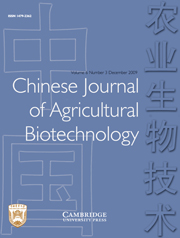Crossref Citations
This article has been cited by the following publications. This list is generated based on data provided by Crossref.
Di Pasqua, Anthony J.
Mishler, Richard E.
Ship, Yan-Li
Dabrowiak, James C.
and
Asefa, Tewodros
2009.
Preparation of antibody-conjugated gold nanoparticles.
Materials Letters,
Vol. 63,
Issue. 21,
p.
1876.
Vidová, Barbora
Tóthová, Eva
Blahut, Ľuboslav
Horváthová, Viera
and
Godány, Andrej
2011.
Multiplex PCR for detection of Escherichia coli O157:H7 in foods.
Biologia,
Vol. 66,
Issue. 3,
p.
401.
Bielaszewska, Martina
Middendorf, Barbara
Tarr, Phillip I.
Zhang, Wenlan
Prager, Rita
Aldick, Thomas
Dobrindt, Ulrich
Karch, Helge
and
Mellmann, Alexander
2011.
Chromosomal instability in enterohaemorrhagic Escherichia coli O157:H7: impact on adherence, tellurite resistance and colony phenotype.
Molecular Microbiology,
Vol. 79,
Issue. 4,
p.
1024.
CHA, Seung Bin
YOO, An Na
LEE, Won Jung
SHIN, Min Kyoung
JUNG, Myung Hwan
SHIN, Seung Won
CHO, Young Wook
and
YOO, Han Sang
2012.
Effect of Bacteriophage in Enterotoxigenic <i>Escherichia coli</i> (ETEC) Infected Pigs.
Journal of Veterinary Medical Science,
Vol. 74,
Issue. 8,
p.
1037.
Saidi, Asiye
and
Mirzaei, Mohammad
2014.
Application of gold-labeled antibody biosensor in simultaneous determination of total aflatoxins using artificial neural network.
Journal of the Iranian Chemical Society,
Vol. 11,
Issue. 2,
p.
391.
Nateghi, Nikta
Karimi, Ehsan
and
Oskoueian, Ehsan
2022.
Nanoliposome-Encapsulated and Non-Encapsulated Phenolics From Achillea millefolium and Their Biological Function in Mice Challenged by Campylobacter jejuni: A Comparative Study.
Frontiers in Molecular Biosciences,
Vol. 8,
Issue. ,
Hassirian, Niloofar
Karimi, Ehsan
and
Oskoueian, Ehsan
2022.
Nanoliposome-encapsulated phenolic-rich fraction from Alcea rosea as a dietary phytobiotic in mice challenged by Escherichia coli.
Annals of Microbiology,
Vol. 72,
Issue. 1,
Shamansoori, Mona Taghipoor
Karimi, Ehsan
and
Oskoueian, Ehsan
2022.
Rheum ribes extract‐loaded nanoliposome as a novel phytogenic antibiotic alternative in mice challenged by Escherichia coli (O157:H7).
Biotechnology and Applied Biochemistry,
Vol. 69,
Issue. 6,
p.
2540.
Mezerji, Zahra kadkhoda
Boshrouyeh, Reza
Razavi, Seyedehfarnaz Hafezian
Ghajari, Shaghayegh
Hajiha, Hasti
Shafaei, Negin
Karimi, Ehsan
and
Oskoueian, Ehsan
2023.
Encapsulation of Polygonum bistorta root phenolic compounds as a novel phytobiotic and its protective effects in the mouse model of enteropathogenic Escherichia coli infection.
BMC Complementary Medicine and Therapies,
Vol. 23,
Issue. 1,

